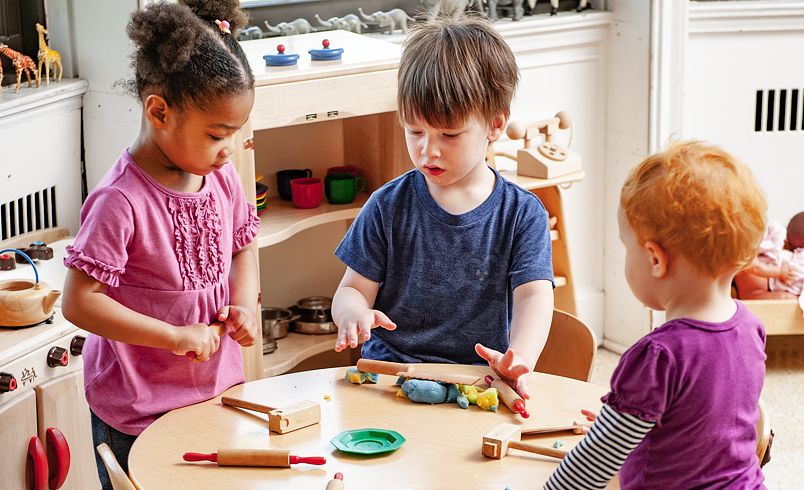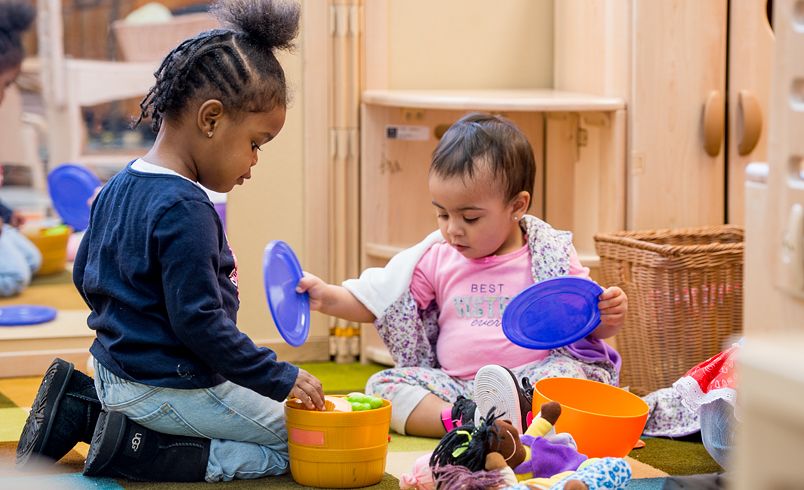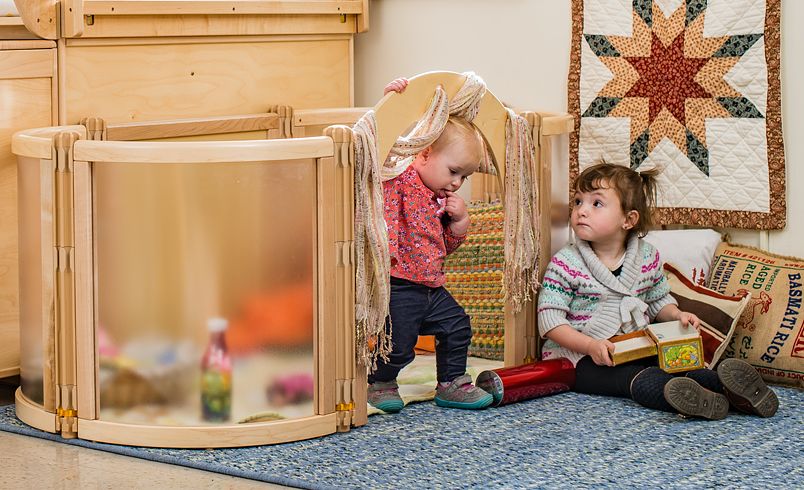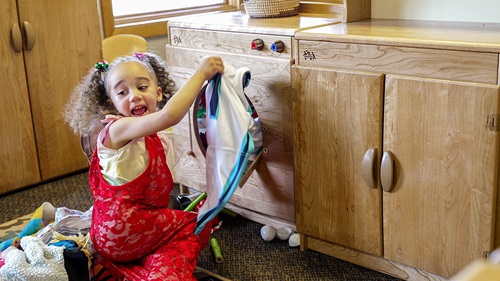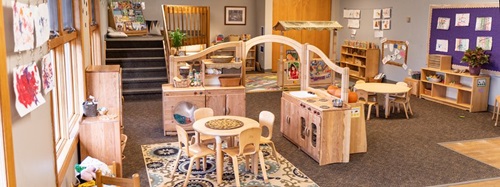Designing Classrooms for Collaboration
| May 2020“Coming together is the BEGINNING
Staying together is PROGRESS
Working together is SUCCESS”
Henry Ford
Collaboration, though not a new concept, has recently become focal terminology in many disciplines. Considered a vital 21st century learning skill, collaboration increases the human and material resources available, facilitating innovative solutions to problems and tasks. As the world discovers the benefits of collaboration, we as educators are charged with the important task of intentionally promoting and nurturing cooperative skills through our learning environments.
Human beings are social by nature. We are born to connect. Toddlers share a hearty laugh when they build a tower together and then knock it down. Preschool children glow with pride after completing a large floor puzzle together. Collaboration requires a certain level of empathy, a shared emotion so to speak, that keeps two or more children working productively together. How can this innate capability and desire to connect with peers and familiar adults be nurtured and supported?
This article focuses on specific design features that help set the tone for collaborative activity in a play space. Interestingly, the information is based on a research study originally designed to increase purposeful play by redesigning preschool classroom spaces. Classroom teachers involved in the study observed children negotiating the materials and play space more effectively after the makeover. The teachers repeatedly reflected on how the subtle flow from one area to another in the classroom increased the level of cooperative play. It appeared that the more opportunities provided for children to be together with enough flex space to maneuver, the more collaborative activity we saw. Further investigation suggests that the following five features of design empower children to P.I.T.C.H. in and work together successfully.
P: Potential units
In the block area of a preschool classroom four children were building a spaceship. What looked like an ideal collaboration suddenly turned into a conflict when two children disagreed on where the door of the spaceship should be. After a fiery exchange of words and even a few tears, three children left the space in search of something new. The fourth child looked around, picked up a piece of the spaceship and took it over to an empty space adjacent to the original space. One child returned and brought over another piece of the spaceship. Eventually all 4 players returned, re-designed the spaceship in the new space and play resumed!
Potential units are empty spaces to which children can add play materials (Kritchevsky, Prescott, and Walling, 1969). Strategically designed potential units permit play to “spill over” into a new space, allowing children to manage conflict in a non-threatening manner and continue work together. They offer children a second chance to start over alone, with a partner, or a group and build collaborative skills at their comfort level. Adding a potential unit is as simple as placing a small square table or a rug near a popular area to offer an optional space. Even a temporary square defined by masking tape on the floor can serve the purpose.
I: Interchangeable furniture arrangements
In an art studio two trapezoid tables, previously put together to create a hexagon, were rearranged to create a long parallelogram. The teacher noticed that with this new work surface children started to ask for larger sheets of paper and created group murals rather than individual art. A regular table can easily be covered with butcher paper for mural art; however, collaborative activity in this case was sustained because children owned that decision. More importantly, the flexibility of returning the two tables to their original hexagon when needed provided the teacher and children a sense of control encouraging joint decision-making about their learning space.
Interchangeable furniture arrangements can be reconfigured depending on the desired purpose of the activity. Flexible spaces enhance collaboration and provide satisfaction. Inflexible spaces are non-negotiable and result in territoriality because they define rigid boundaries. Even in play, when a structure becomes large and seems more permanent children revert to territorial language, “You can’t come in here.” Push tall furniture to the wall, then begin placing shorter furniture in a descending order towards the center of the room. Use small, moveable furniture that can be rearranged in multiple ways where children engage in play so they can learn to set boundaries for themselves. Engage the children in decision making to encourage community and a sense of belonging.
T: Tubs, Trays, and Towels
The children wanted to build a maze for the class hamster to play in. However, the pet refused to come to block area. As children started carrying blocks over to the hamster’s preferred spot, two children realized that the willow basket holding the wooden blocks had two handles and attempted to move the heavy basket. Two other children joined in to help and soon a maze was built in the new area and the Hamster was happily running through.
The purpose of containers in an early childhood classroom is to spark interest in the contents. (Duncan and Patet, 2016). Intentionally placed tubs and trays can also prompt collaboration. Assorted sizes of larger tubs and trays with easy grip holders prompt children to collaborate while transporting materials. Beach towels or blankets can also be used by two or more children to move lose parts to a different part of the room. By working together children learn to rely on each other in order to accomplish a goal.
C: Connectors
In a classroom where the teacher was concerned about children’s safety running up and down the stairs of a loft, we repositioned the loft stairs towards the play kitchen, creating a flow between the two spaces. In the small space between the staircase and the stove, we put an ironing table, with a phone, calendar, and a white board on the wall. Children frequently carried on pretend phone conversations while ironing clothes for the moms caring for baby dolls in the loft, and scribbling orders on the white board for the kitchen crew.
Connectors provide children with a space to connect their play to the play of children on either side of them. In the above scenario, purposeless running was turned into purposeful play with the added benefit of collaboration. In another room, a car mat placed between an open block area and a comfortable retreat created with pillows under a table, provoked children to build roads to block structures on one side and go through the ‘tunnel’ on the other side. Three groups of children played cooperatively in their own cluster and across the three spaces with the other groups. Connectors provide children with personal space to interact within their comfort zone and an opportunity for learning to negotiate space.
H: Havens and lookouts
A frantic teacher approached me one day. “I can’t find Johnny anywhere. I know we all went into the activity center together. I know he was here.” We searched until someone’s eyes fell on a large yellow tub that typically held balls. It was laying on its side rocking back and forth. Sure enough, Johnny was curled up inside, content and watching three other children horse playing on the carpet.
Small defined spaces or havens allow children to retreat into spaces and feel safe. Children of all ages need a space to withdraw from over stimulation. Deliberately creating quiet areas in the classroom for children to retreat helps lower sensory overload (Parks, 2018). Lookouts or posts work in a similar fashion. Not only do they allow children to withdraw physically but give them a chance to survey the next space they want to enter and decide if it feels safe. Depending on the age of the child, pop up tents, bedsheet forts, half barrel rockers, or a smaller book nook can serve this purpose. It is amazing how much a short time with a few deep breaths in a haven or lookout can do especially for a child who is learning to collaborate.
So, are you ready to P.I.T.C.H in and use these design features to create spaces that encourage and stimulate collaboration?
References:
Curtis, D. & Carter, M. (2015). Designs for living and learning: Transforming Early Childhood Environments. (2nd Ed.). St. Paul, MN: Redleaf Press
Duncan, S. & Patet, P. (2016, November 1). Sparking young children’s engagement: How to use creative and unconventional containers in your classroom. Retrieved from http://www.communityplaythings.com/resources/articles/2016/containers
Kritchevsky, S., Prescott, E., & Walling, L. (1969) Planning environments for young children: Physical space. Washington, D.C.: NAEYC
Parks, L. (2018). Sensory overload: Quieting the noise in early childhood classrooms. Texas Child Care Quarterly, 41 (4)

